What Are B2B Ecommerce Best Practices?
B2B ecommerce best practices are guidelines that help businesses with ecommerce sites more successfully sell products to other businesses.
These best practices can improve user experience, conversion rates, and customer satisfaction.
Here are 18 ecommerce best practices B2B businesses can use.
1. Ensure Your Site Is Error-Free
A B2B ecommerce site that runs smoothly can attract more visitors and convert them at higher rates.
Elements like fast page load times, functional links, and good navigation improve user experience and help people effectively use your site. When people can use your site with ease, they’ll be more likely to convert.
Plus, an error-free website improves your visibility in the search results. You can rank higher and drive more traffic back to your online shop.
Use the Site Audit tool to check for errors on your site.
To get started, open the tool. Click the “+ Create project” button.

Fill in your domain and project name (optional). Then click “Create project.”
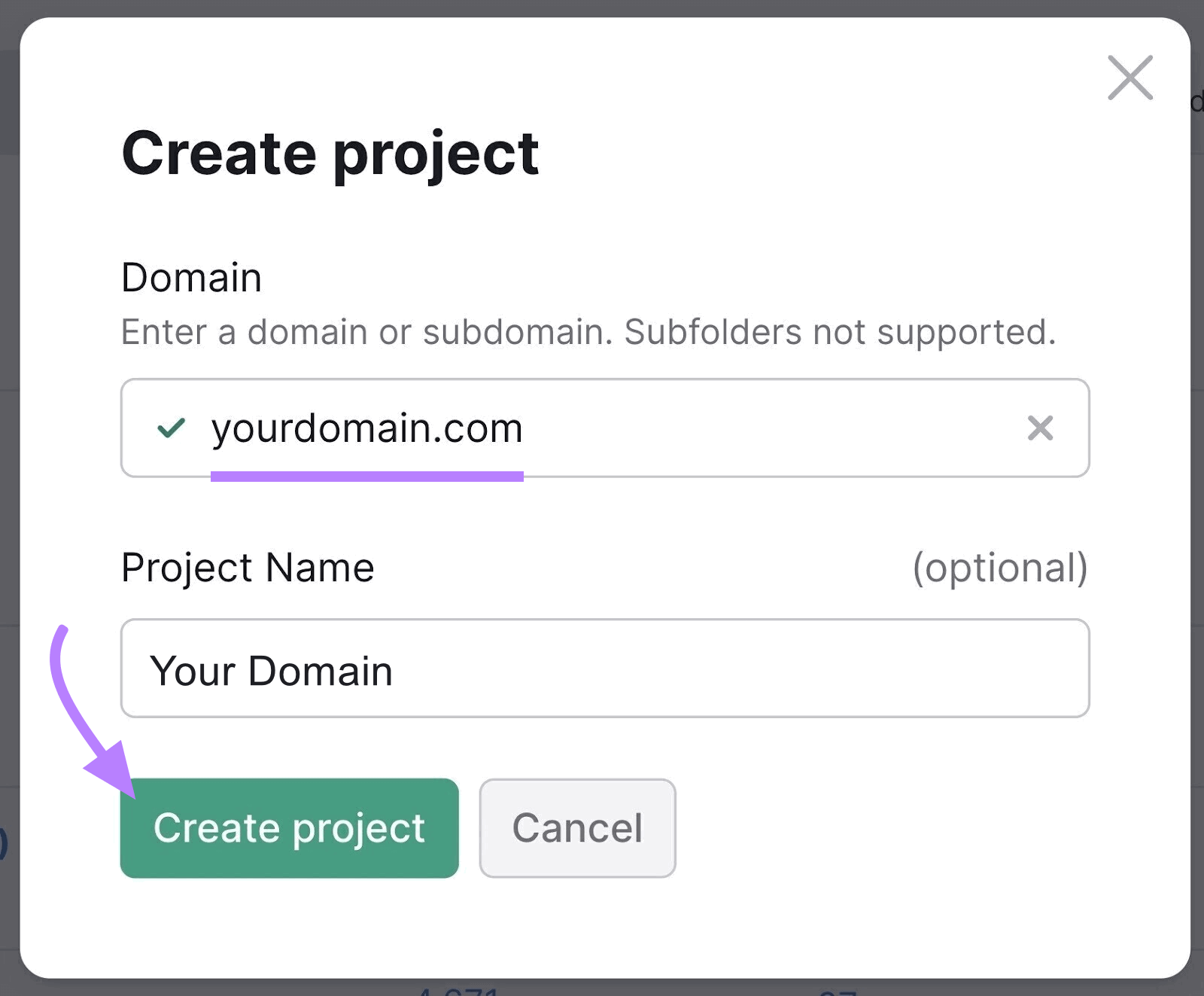
In the “Site Audit Settings” menu, follow the prompts to set up your project. Our detailed setup guide can help you configure the audit for your needs. Or, the defaults are a good place to start.
When ready, click the “Start Site Audit” button.
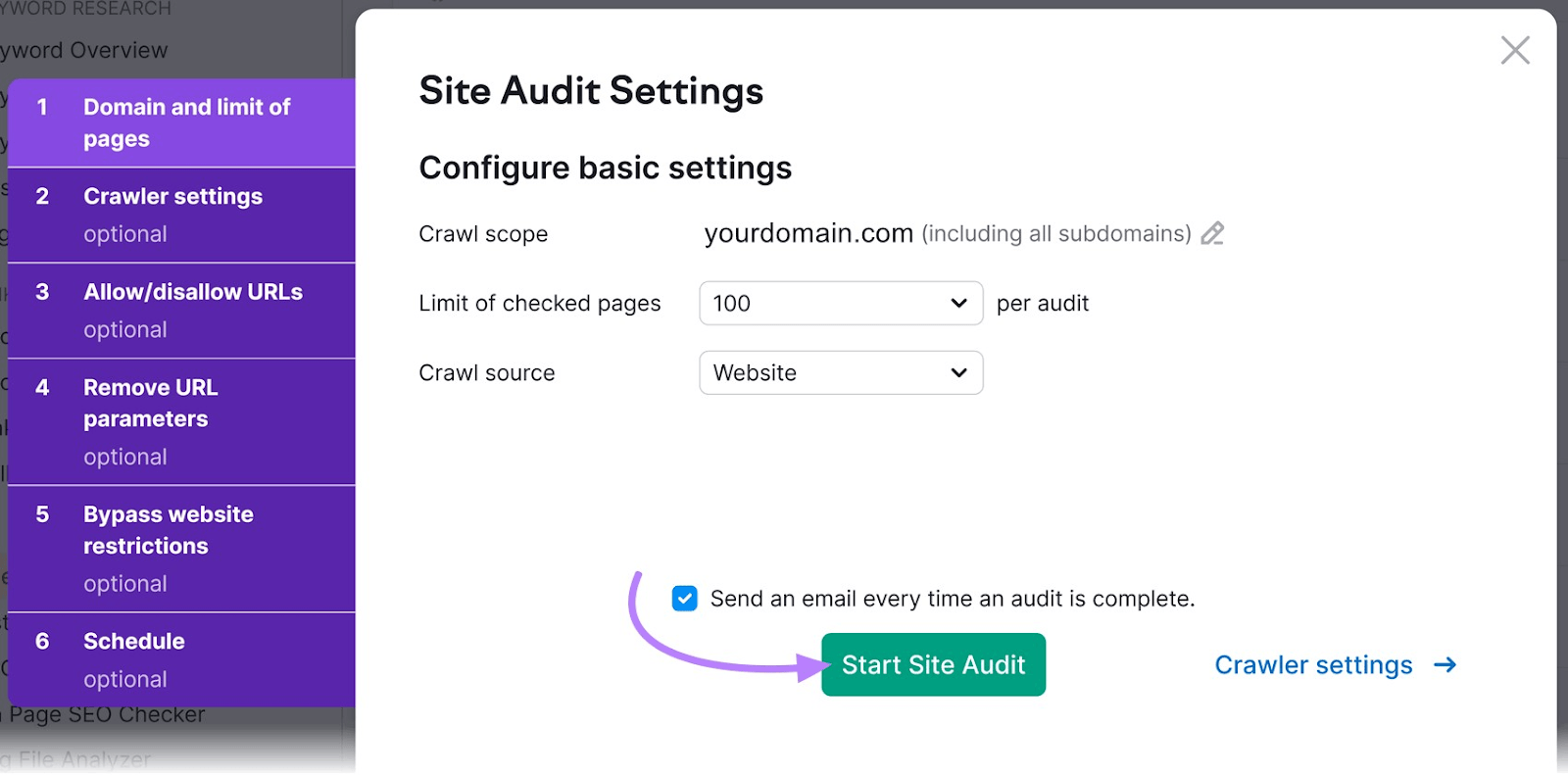
Site Audit will take a few minutes to conduct a complete audit of your domain.

Once the “Pages Crawled” column shows that all pages have been crawled, click the name of your project to review the detailed results.

Click the “Issues” tab for a list of things to fix.
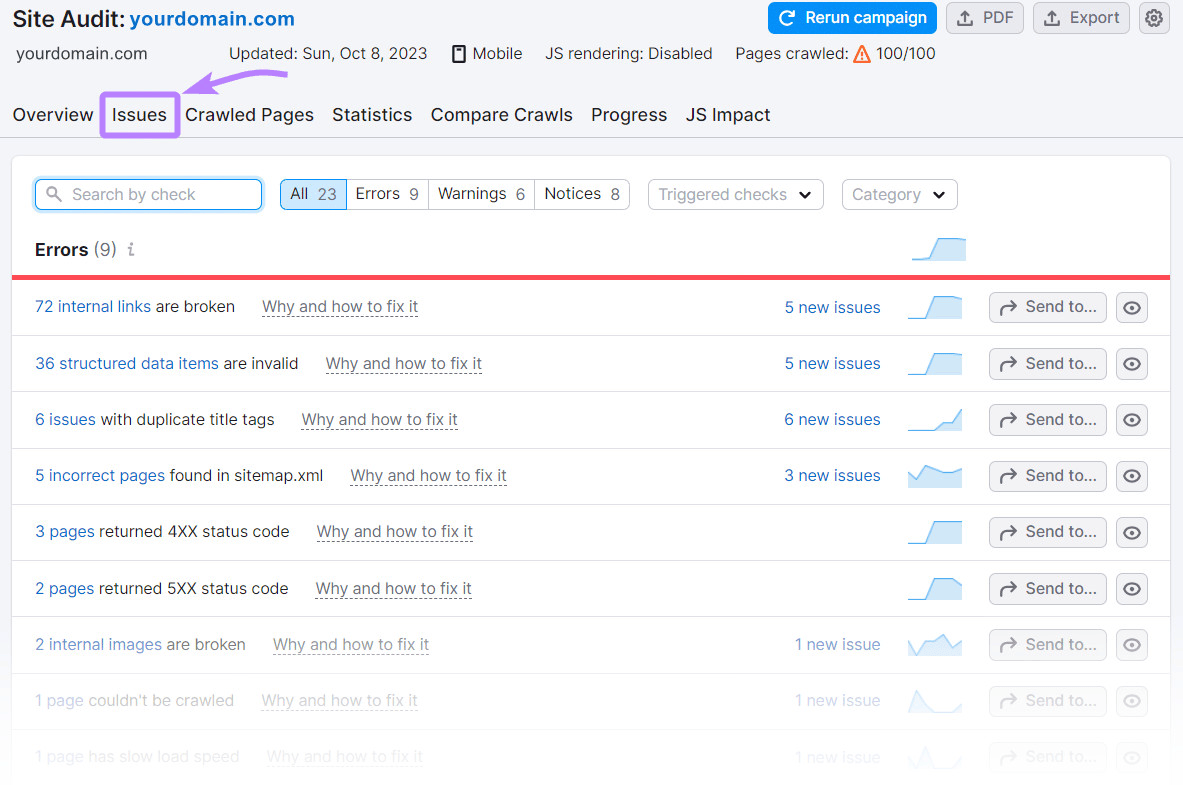
Common issues include things like broken images, broken links, and URL return errors.
These issues are sorted into “Errors” (most severe), “Warnings” (medium severity), and “Notices” (least severe).

Use these classifications to prioritize what to fix first.
To check site speed, go to the “Overview” tab. Look for “Thematic Reports.” Then click “View details” under “Site Performance.”
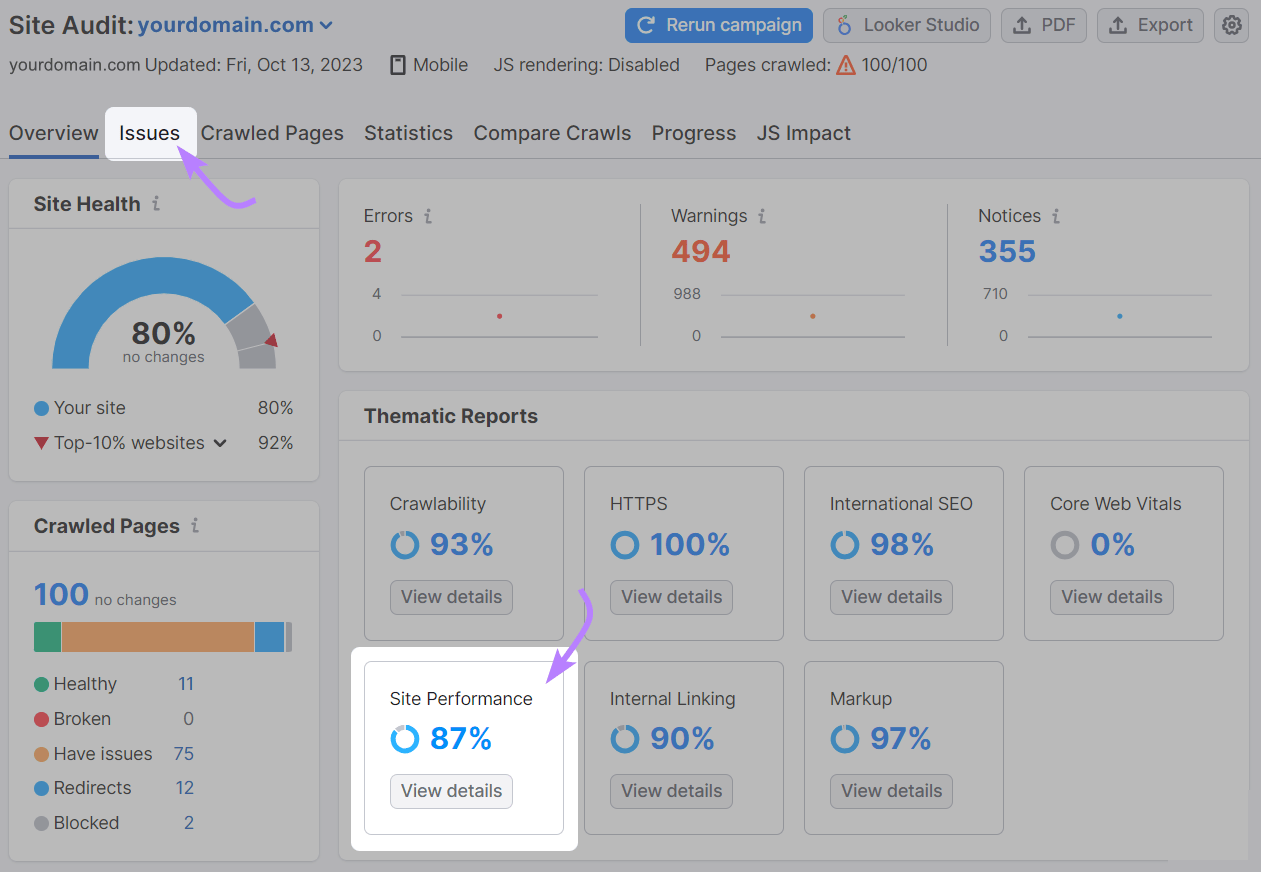
The “Site Performance” report provides insight into your page speed. You can work through the errors, warnings, and notices to improve your page speed.

Further reading: What Is Page Speed & How to Improve It
Make sure you perform audits regularly to catch new errors.
You can schedule automatic audits by clicking the gear icon in the upper-right corner of the project’s homepage. Scroll down the “Site Audit settings” section and click “Schedule.”

Choose how often you’d like to run audits. You can select from weekly audits (on specific days of the week), daily, or once.
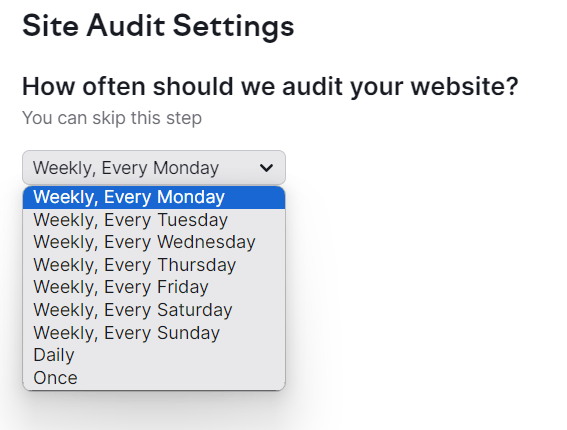
We recommend starting with weekly audits. But you can change your audits to daily if you’d like to keep a closer eye on site performance.
2. Optimize Product Listings
High-quality product listings on your ecommerce site can attract more buyers.
There are three areas to optimize:
- Product categories
- Product imagery
- Product copy
Product Categories
Organizing products into relevant, easy-to-understand categories. This makes it simple for prospects to find the products they need.
The categories you create should depend on your customers and be based on the details they find most useful.
For example, envelope company Site Audit categorizes their products according to popular features like color and material.
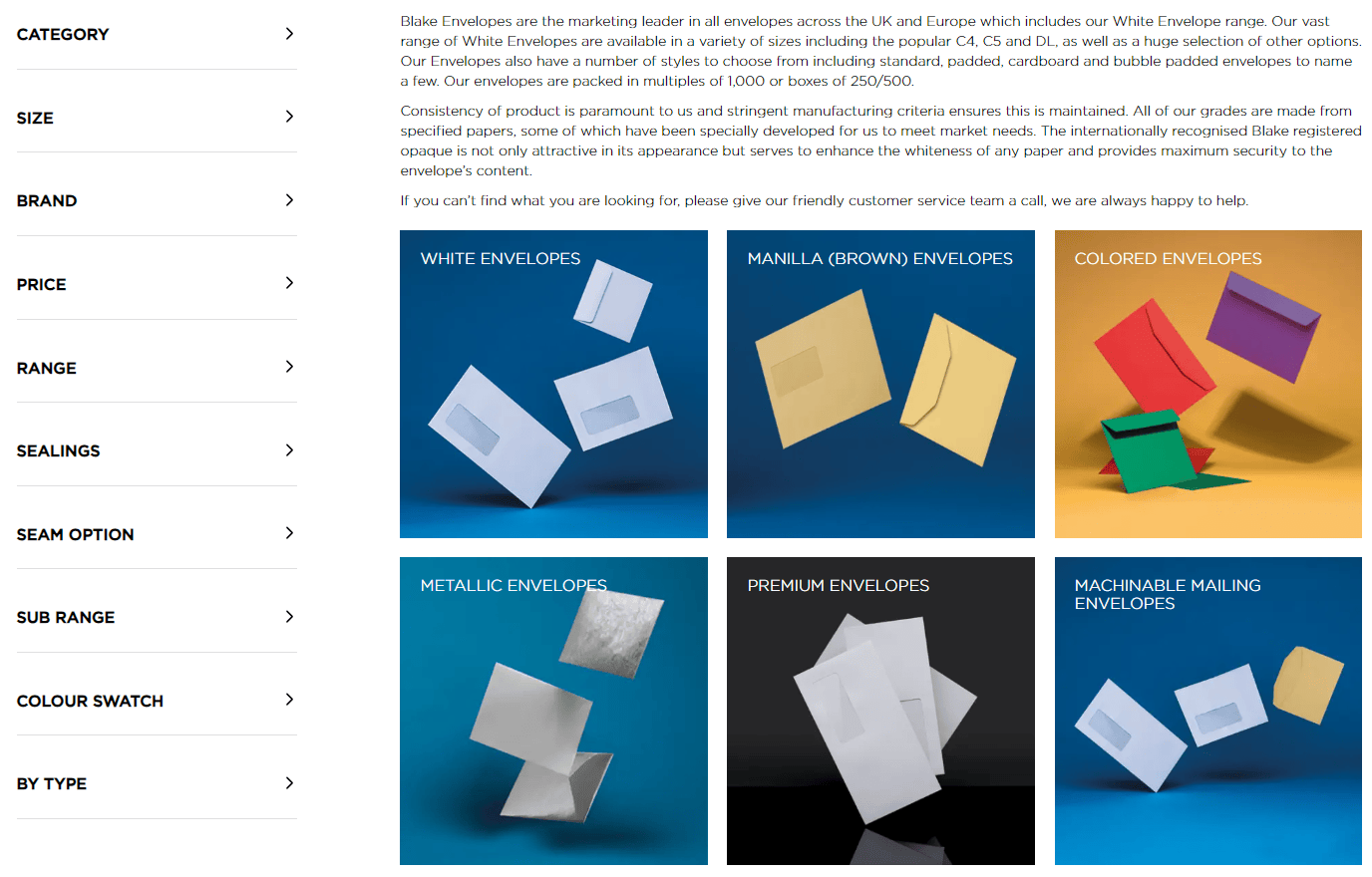
Review your site search data—the terms people use in your site’s search function—to see which search terms people use to find what they need.

Look for patterns you can use to create categories for your products.
If your analytics doesn’t collect site search data, reach out to a developer to set it up for you.
Product Imagery
High-quality product imagery makes your brand appear professional and helps instill trust.
If you sell physical products, include several photos of each product to showcase different angles. This way, consumers can get a good look at your product without needing to view it in person.
For example: B2B retailer Quill includes multiple images for their paper cup listing:

Product Copy
Good product copy, like titles and descriptions, can increase conversions and get more traffic to your site.
Your product title should accurately describe what you sell.
Take Envato Market. They sell themes for WordPress sites. On this product page, the title names the theme and describes who it’s for (in this case, lawyers and consultants).
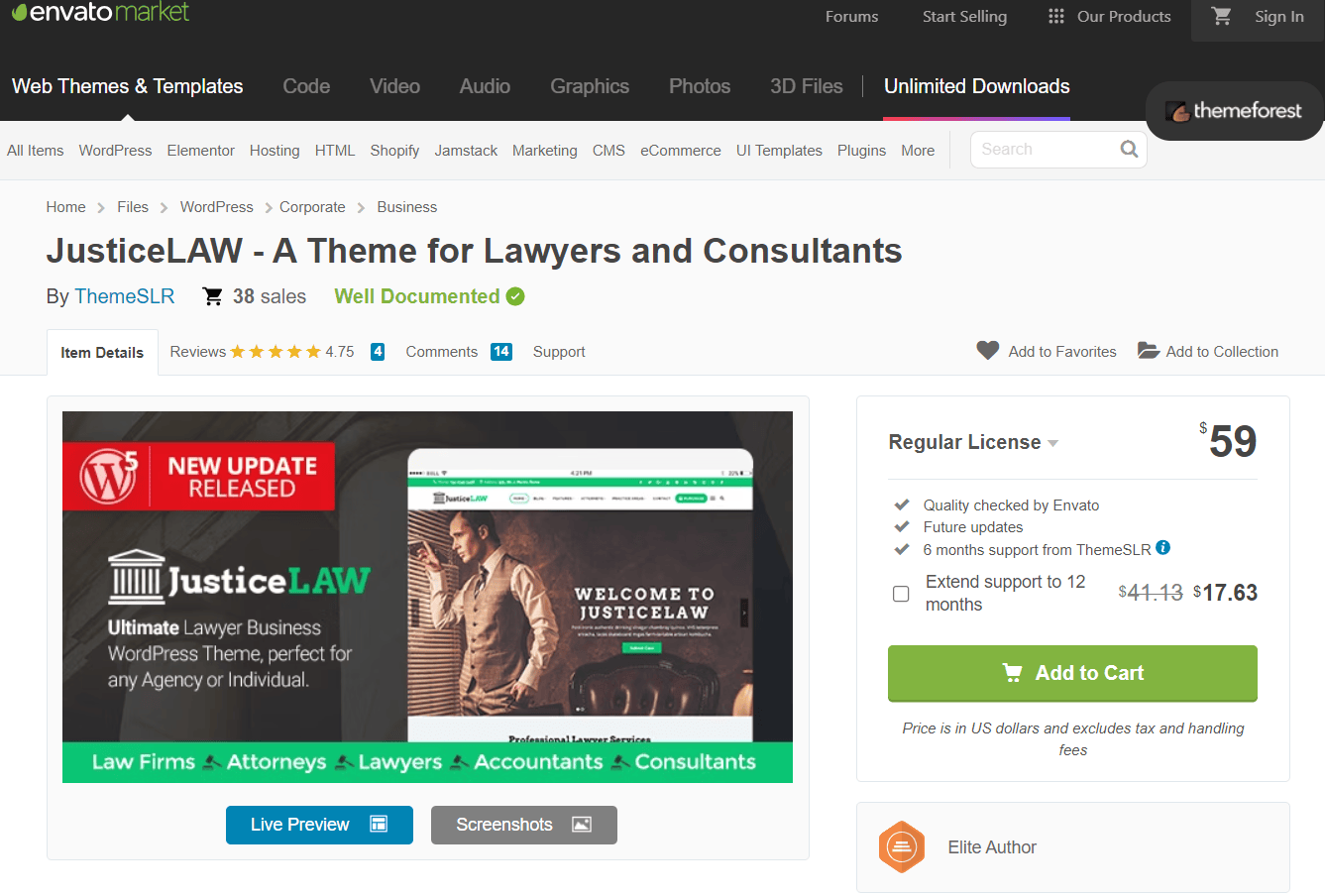
Product descriptions should highlight product details that your buyer would need to know, like features, quantity, or dimensions.
Notice: on the JusticeLAW product page, Envato Market includes the date the theme was published, whether it’s high resolution, whether it’s widget ready, what browsers it’s compatible with, and how many columns it has for content.
The information in the description should help prospects decide whether this is the right product for them.
The description should also describe the benefits of your product. So prospects will understand how your products will satisfy their needs and goals.
Cosmetic distributor Cosmetic Packaging Now highlights product features and benefits in their product description:
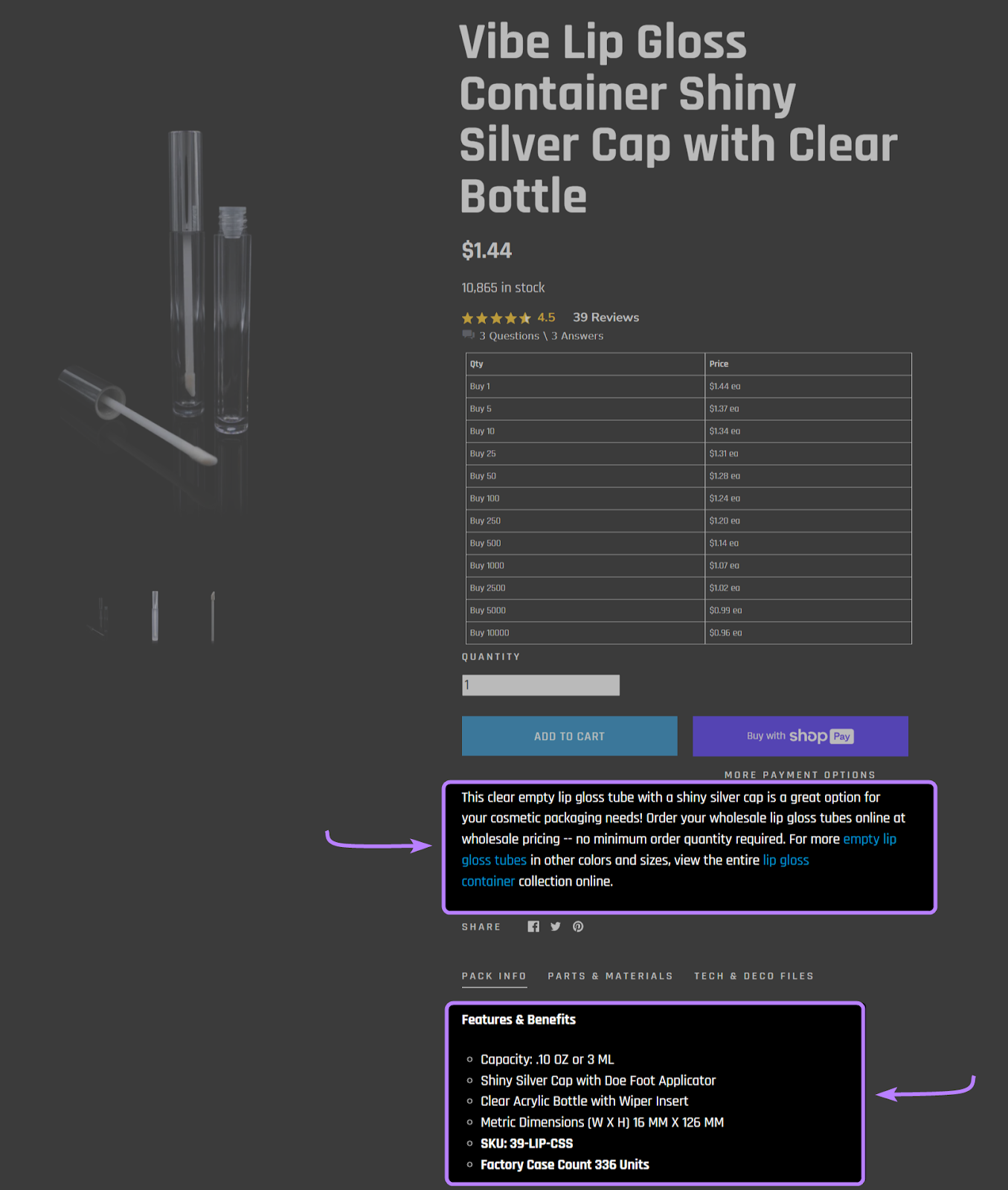
Lastly, make sure to incorporate keywords into your product descriptions and titles.
Keywords—words or phrases people search for—help search engines understand your content and rank it in the search results. The higher your content ranks for relevant keywords, the more searchers will find you.
Use the Keyword Magic Tool to determine which keywords to include in your product descriptions and titles.
To start, open the tool and enter a short description of your product in the text field. For example: bulk paper towels.
Select your location in the drop-down. Then click “Search.”

Review the suggested keywords.
You’ll select a few variations to include in your product description.

In our example, we might use “bulk paper towels,” “paper towels in bulk,” and “bulk paper towel” based on this keyword list.
Just make sure you don’t include too many keywords. This is known as keyword stuffing. It’s a spammy practice that could hurt your rankings, according to Google.
You’ll know if you have too many keywords if your copy sounds unnatural. Or if the keywords you’ve included sound forced.
To help you write better product copy, use the SEO Writing Assistant.
Open the tool and click “+ Analyze new text.”

Enter the keyword(s) for your product listing in the “Keywords” input area on the right. Adjust your target audience (location, language, and device). Then click “Get recommendations.”
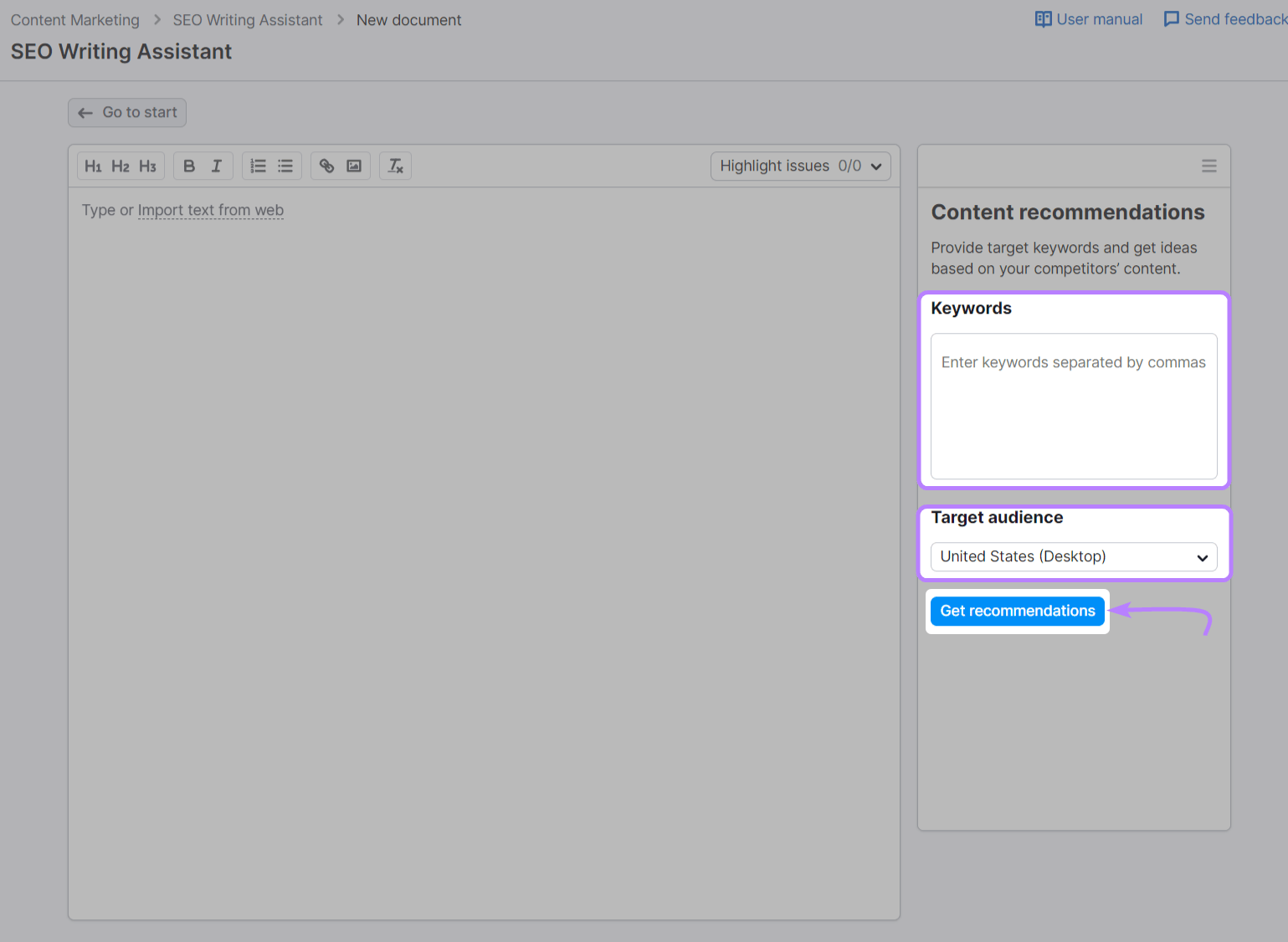
Now copy your product description into the text box on the left.
The SEO Writing Assistant will grade your description and give you tips to improve it.
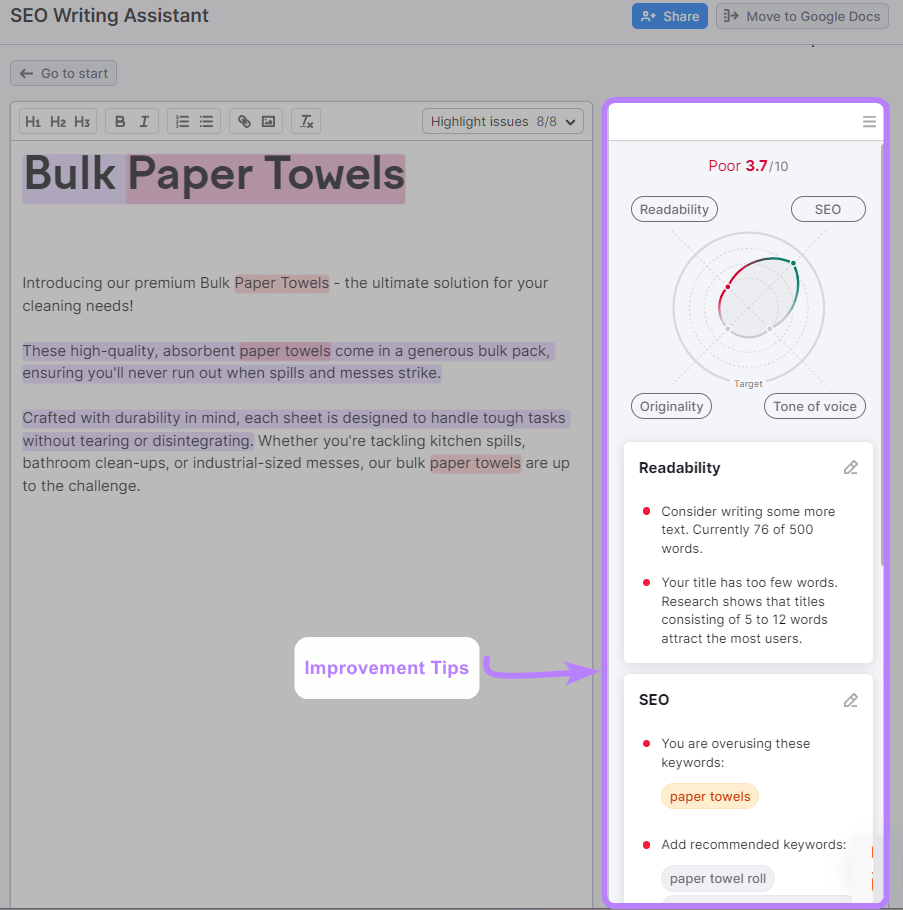
3. Optimize Site Navigation
Users will stay on your site longer (and potentially convert) if they can easily find the information they’re looking for.
For example, say a user wants to ask your support team a question. But they don’t see a link to your support page. They might get frustrated and leave.
To fix this, add links to key pages to your site’s visible menu.
Site navigation also helps search engines understand the structure of your site. That means you can rank higher in the search results.
Printing company Vistaprint’s well-organized site navigation makes it easy for prospects and current customers to find what they need. From products to support pages, users are only a click away from important content.

Intuitive site navigation lets prospects explore your site with ease. And prevents them from feeling frustrated and leaving.
You can use site menus to organize your website structure further.
Notice: When you hover over Vistaprint’s navigation, a well-organized menu appears, with links to other pages users might find important.

Also consider enabling breadcrumbs on your site—a navigational path made of links—to aid navigation. Like this:

Breadcrumbs let users understand where they are on your site. They can explore without getting lost.
In the example above, users looking for a MacBook could quickly click on the “Computers & Tablets” link to explore other types of devices.
Lastly, remember to optimize the navigation in your footer (the section at the bottom of your site). Footers are your opportunity to highlight useful content that you might not focus on in your main navigation.

Your footer can include:
- Links to contact pages or contact information
- Links to social media profiles
- Email sign-up forms
- Links to legal documents (like your Privacy Policy and Terms & Conditions)
- Links to support pages and help center documents
4. Improve Site Search
Creating a robust search experience is one of the most potent B2B website best practices.
The search bar on your site lets prospects find what they need. Ultimately it can boost sales and user satisfaction.
Here are some tips:
- Make the search bar easy to locate. Ensure the search bar is accessible for quick product searches—preferably at the top of the page.
- Account for misspellings. Add incorrect spellings to your search function so users can find what they need even if they didn’t spell the word properly.
- Include search results with images. Search results with product images, prices, and quantities make it simple for users to find what they need.
- Add predictive search. Enhance the search experience with predictive or autocomplete suggestions that appear as users type queries.
- Add suggestions. Add product suggestions to help customers find something they might not realize they need.
Here’s an example of a user-friendly search bar from heavy-duty parts manufacturer FleetPride.
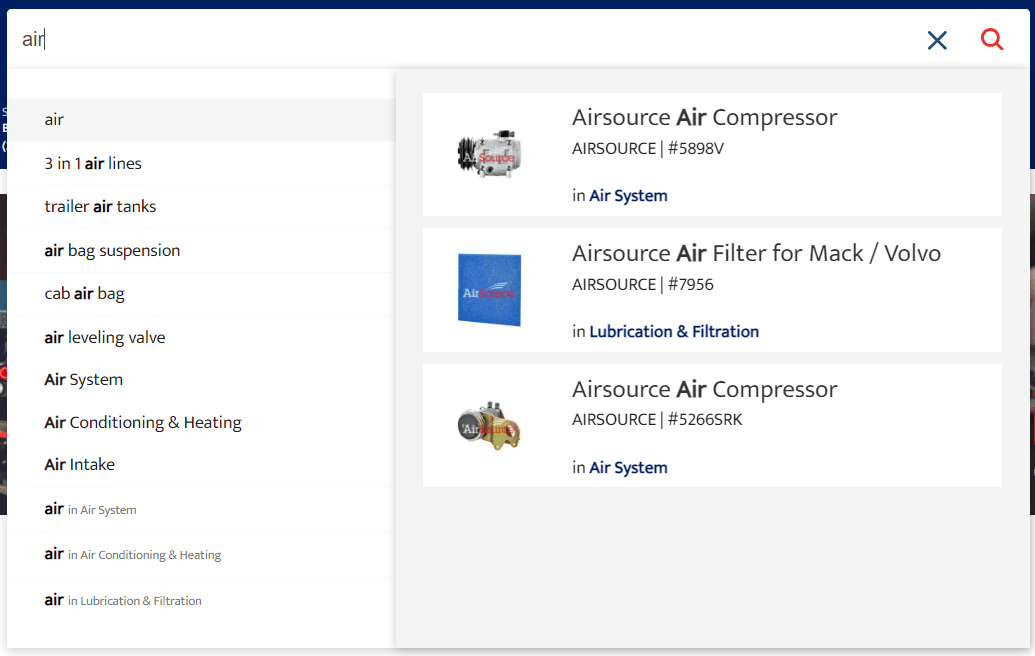
By improving your site’s search, users can find what they need faster. And ultimately, more easily make a purchase.
5. Optimize Your Site for Mobile
You can improve user experience by having a website that’s easy to navigate on both desktop and mobile devices.
Imagine your prospect is away from their desk when they realize they need to place an order with you. They pull up your website on their phone.
If your mobile site is user-friendly, they’ll be able to place their order with a few taps.
But if your mobile site is hard to navigate, they might get annoyed, and choose to buy from a competitor.
You can optimize your site for mobile by:
- Ensuring mobile pages load fast
- Including large and tappable buttons
- Making sure the font is large and easy to read on smaller screens
- Using a responsive design that adjusts to screens of varying sizes
- Incorporating mobile payment options
6. Make It Easy to Get a Quote
If you don’t have transparent pricing alongside each product, instruct prospects on how they can get a custom quote.
Otherwise, they might get confused and head to a competitor.
Industrial supplier Gardner Denver does this by adding a “Request a Quote” button alongside their products:

Clicking the button brings users to a brief form.
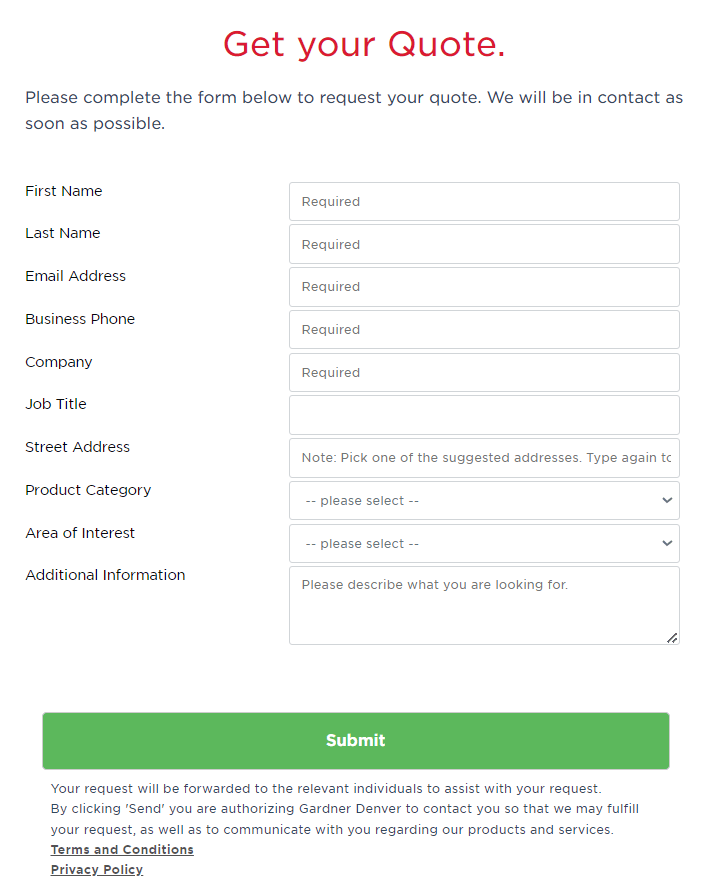
B2B pricing can be complex. Avoid passing that complexity on to your prospects. Make it clear how they can get a quote.
7. Streamline the Purchase Process
Simplifying the purchase process turns more prospects into buyers.
The B2B buying process is complex. It often involves multiple people and extensive product evaluation. The last thing you want to do is snag up a customer who’s made it far enough to attempt a purchase.
Your goal?
Make it as easy as possible to complete a transaction.
Consider a one-page checkout where customers can review their order and enter details (like shipping information and payment details) all in one go.
Provide a variety of payment methods. Like credit cards, Apple Pay, PayPal, and AHC payments.
This gives customers flexibility. And increases the likelihood they’ll complete the purchase.
Lastly, provide invoices immediately after checkout (if possible). B2B customers often need invoices for accounting purposes. They’ll appreciate having one right away.
8. Secure Your Transactions
Customers will be more willing to trust you if they know you’ll process their transactions in a secure way.
B2B transactions often involve large sums of money. Businesses need reassurance that their funds won’t be compromised or lost during the transaction.
First, make sure your site serves HTTPS. Hypertext Transfer Protocol Secure (HTTPS) ensures information sent to your website—like payment information—remains private and secure.
You can check to see if your site has HTTPS by looking for a padlock beside your URL:

HTTPS is also a ranking factor. Not only will it instill trust in your users, it may also help you rank higher in the search results, according to Google.
Then, make sure to secure payment gateways, so customers feel comfortable moving forward with their purchase. Work closely with your web developer to ensure your payment gateways have robust security measures, like two-factor authentication.
9. Make Reordering Simple
You can enhance customer experience (and grow your bottom line) by making it easy for customers to reorder.
If it’s challenging for customers to make repeat purchases, they might end up buying from a competitor.
Make it easy for customers to reorder by:
- Adding reorder links to digital invoices and confirmation emails
- Setting up automatic (and pre-authorized) reordering options
- Adding reorder links within customer portals
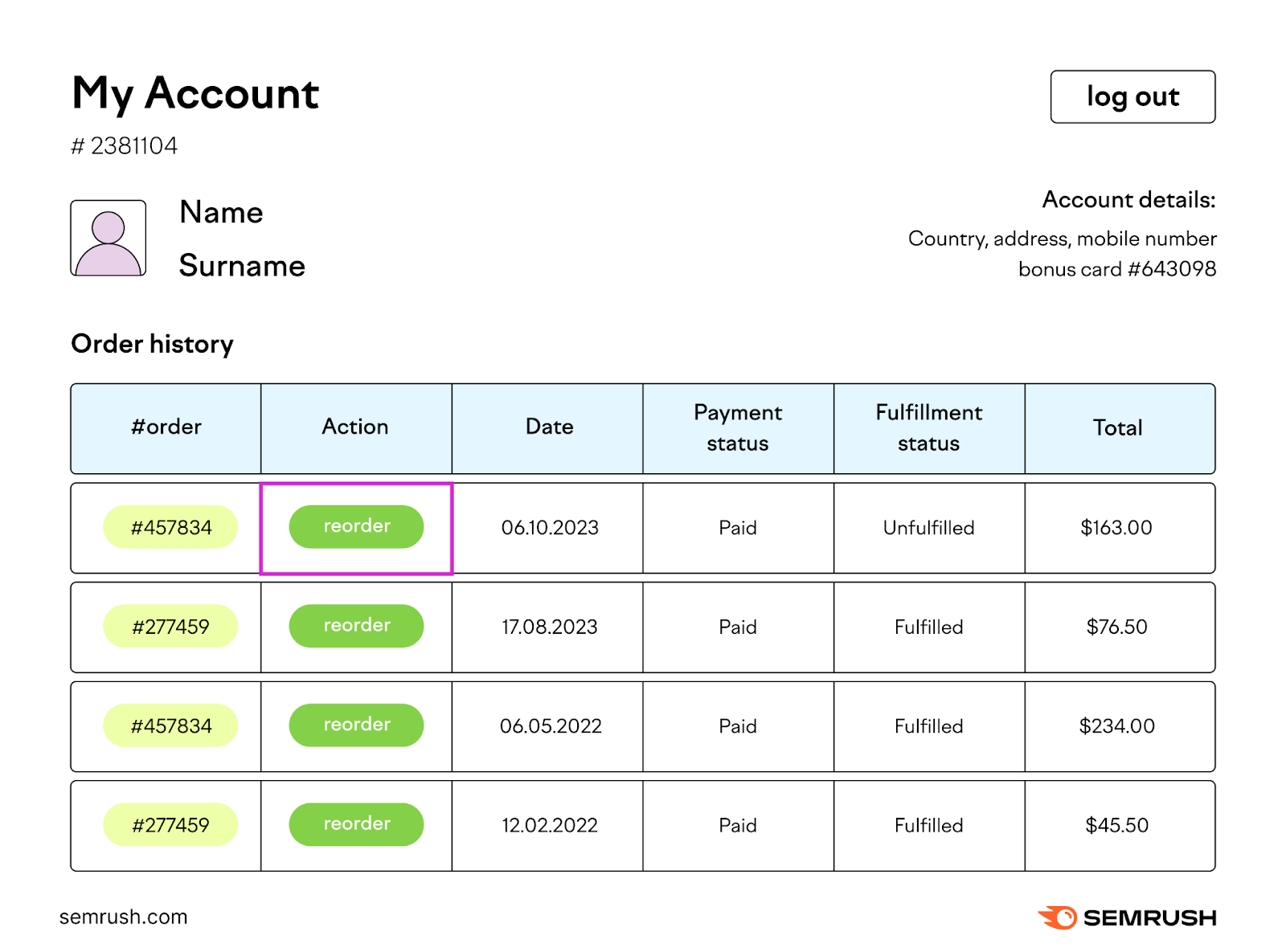
This way, customers don’t need to search your site to try and find the product they want to order again. (Or try to remember what they previously ordered.)
10. Refine the Post-Purchase Process
The best B2B customer experiences don’t end when a transaction is complete.
Stay in the loop with customers after they purchase. This gives you an opportunity to ensure their satisfaction and lets you gather valuable insights.
Your post-purchase process should include:
- Order confirmation emails so customers know their order went through
- Order status emails so customers know what’s happening with their order
- Shipping and tracking information so customers know when to expect their products
- Delivery updates to notify customers of successful deliveries or delays
Customers will be less likely to reach out to you with questions when they know the status of their order.
You should also send out a customer satisfaction survey after customers receive their products.
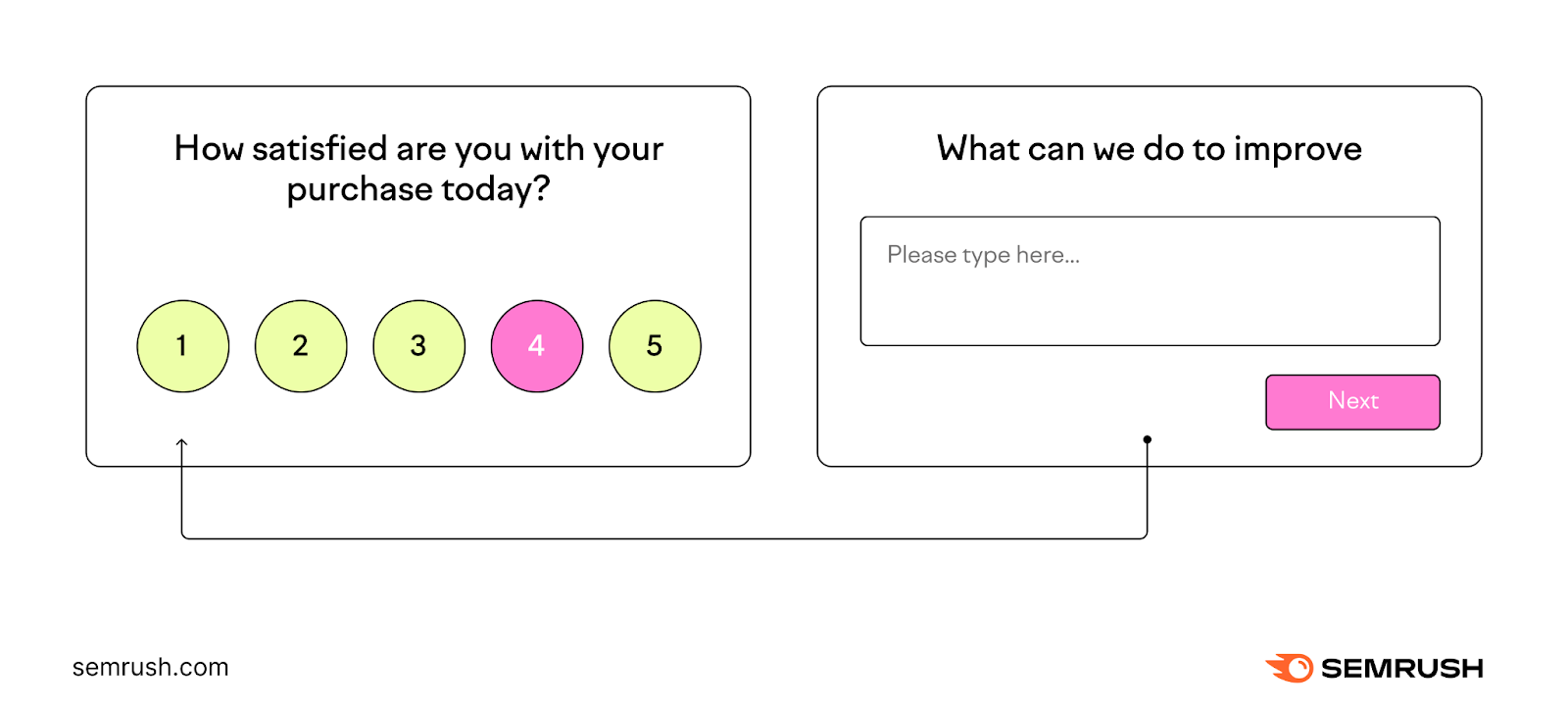
Customer satisfaction surveys let you pinpoint areas of frustration throughout the buying process. Use this feedback to improve and refine the process.
Your customers will be delighted when they see you’ve implemented their feedback.
11. Create Content to Attract Prospects
Useful content—like blogs or knowledge base articles—can help you attract prospects if it ranks highly in the search results.
For example, let’s say you sell industrial sewing supplies. You can publish informative articles about industry trends, buyer’s guides, and equipment maintenance tips.
Then, when people search for topics related to your industry, they’ll (hopefully) click your website in the search results.

After reading your content, they might sign up for your email list, reach out with further questions, or become a customer.
If your content links to relevant products, they might even click through and make a purchase right away. This is a great way to convert readers to buyers.
Here’s how to write content with the best chance of ranking highly in search results.
Before writing content, it helps to know which keywords you want to rank highly for.
Keyword Strategy Builder can help.
To start, open the tool, add a few seed keywords (keywords that describe your product or niche), choose a location-based database, then click “Create list.”

It can take a few minutes for Keyword Strategy Builder to prepare your lists.
Once they’re ready, you'll see your topic broken down into main topics, or pillar pages, and subtopics. Go through the clusters to find a topic you want to craft a blog post about.

After choosing your topic, click the “Write content” button.
Choose whether you want to write for mobile or desktop users. Then click “Send keywords.”
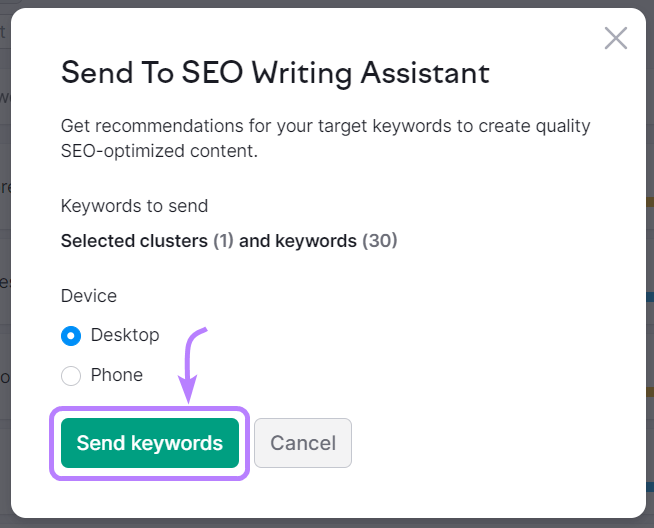
This opens the SEO Writing Assistant where you can write your blog post directly in the editor.
The SEO Writing Assistant grades your text based on its readability, SEO, originality, and tone of voice.

Use the suggestions to improve your content so it reads well and has a better chance of ranking highly.
You’ll want to write and publish content on a regular basis, following a schedule that fits your business. Some businesses may find they have capacity to publish one article a day. Others may publish one per week.
With a consistent publishing schedule, you’ll always have fresh content for search engines and your audience.
12. Create Empowering Content to Retain Customers
Customers are less likely to move to a competitor if they have a great customer experience, according to Qualtrics.
That’s why your ecommerce content strategy should also include content that helps your current customers.
You could put together maintenance guides, troubleshooting manuals, or best practice documents. These help customers solve issues and get the most out of their purchases.
Figure out what customers struggle with—either by speaking to them or talking with support staff.
Then, write content that supports them in those struggles.
For example: Dental supplier Henry Schein made a library of quick reference guides:

These guides teach their customers to manage their accounts and place orders. This way, customers don’t need to rely on—or wait for—someone else to solve issues for them.
Content doesn’t have to focus on problem-solving to be useful. Writing about industry trends, sharing case studies, or providing thought leadership not only keeps customers engaged and your brand top of mind—it also positions you as a trusted expert in the field.
For example: If your company provides bookkeeping services to other businesses, you could write an article with top tips businesses can use to survive tax season.
You’re not pitching your product directly, but you’re entertaining and informing your target audience. This encourages them to build a relationship with you.
13. Use Customer Insights to Personalize User Experiences
Personalizing the user experience makes users feel understood and valued. This makes them trust you more.
Personalization isn’t just a nice touch anymore: 52% of consumers and businesses now expect personalized experiences, according to Salesforce.
Personalize the B2B user experience using data available from their interactions with your brand.
You can look at:
- Behavioral data like what they’ve searched for on your site and what pages they’ve visited most often. Then, serve up more of that content in emails and on-site recommendations for that user.
- Transactional data like their average order value, their purchase frequency, and usual purchase timing. Use those insights to trigger an appropriate up-sell campaign or a special offer right before their next likely purchase time.
- Customer profile data like their role within the company. This lets you send content that’s highly relevant for that individual—like a newsletter that includes marketing tips in the CMO’s version and tech trends in the CTO’s.
Your customers will appreciate the added personalization when it results in more relevant experiences for them.
14. Ease Decision Making with Useful Content
Helpful and informative content—like product guides or regulatory documents—makes decision making easier for prospects.
Your potential customer may have several people involved in the buying process. Like legal departments, managers, and end-users.
Each person needs specific information to decide if they want your product:
- A legal team might want to know if your product complies with local laws
- Managers might want to know how their workflows are going to be impacted
- End-users might want to know if your product integrates with the systems they already use
First, figure out who’s involved in the decision-making process. Ask customer-facing teams or even customers directly.
Then, find out which questions they need answered in order to feel confident buying your product. Create content to satisfy these questions and ease their concerns.
This way, prospects can gather up the information they need to present to stakeholders. And ultimately, come to a decision faster.
Here are a few examples of content you can create:
- Detailed product catalogs
- Informational videos
- Product guides
- Regulatory documents
- Infographics
- Use cases
- Case studies
- Customer reviews and testimonials
- Product comparisons
- Return policies
Corporate gifting platform Chocomize features various case studies and use cases. These help potential customers see how they could use Chocomize’s product.

15. Offer Robust Customer Support
Great customer support builds trust and loyalty. It also improves customer confidence and satisfaction.
For superb customer support, make sure:
- Support staff members are knowledgeable
- Avenues for support are accessible
- Questions are answered in a timely manner
Knowledgeable Support Staff
Make sure you have a dedicated customer support team.
They should be highly knowledgeable about your products and ready to answer any queries thrown their way.
Accessible Support
Customers should know how they can get in touch with your support team. And getting in touch with support should be easy.
Consider adding a page on your website that directs customers to various avenues for support. Like phone numbers, email addresses, live chats, and support forums.
See how office supply company Uline’s contact page lists FAQs, contact info, and a link to a live chat. Customers and prospective customers can choose which support channel suits their needs.

Being available to help improves customer satisfaction. It makes customers feel like they made the right decision in choosing to do business with you.
Timely Responses
Answer questions as soon as possible. Availability may differ depending on the support channel, so it’s best to be upfront about wait times.
For example, typical response times for support emails are around 12 to 24 hours. But a request for support via chat should be answered much sooner—likely within a few minutes.
Tell your customers how soon they can expect a response from each channel. The proactive transparency gives customers a reference point so they don’t become frustrated waiting for a response.
Electronic retailer Monoprice lists the hours beside phone and chat support so customers know whether their requests will be answered right away.

16. Collect and Analyze Analytics
Analytics tell a vivid story about your audience. They often lead to insights that you can use to improve your offerings, guide your business decisions, and, ultimately, increase customer satisfaction.
For example: let’s say you notice the bounce rate—the number of people leaving a page on your site without going to another one or completing another specified action—is high on your product page.
After reviewing the page, you hypothesize that your product images aren’t drawing people in.
With your hypothesis, you can perform an A/B test. This is when you test two variations of one variable against each other.
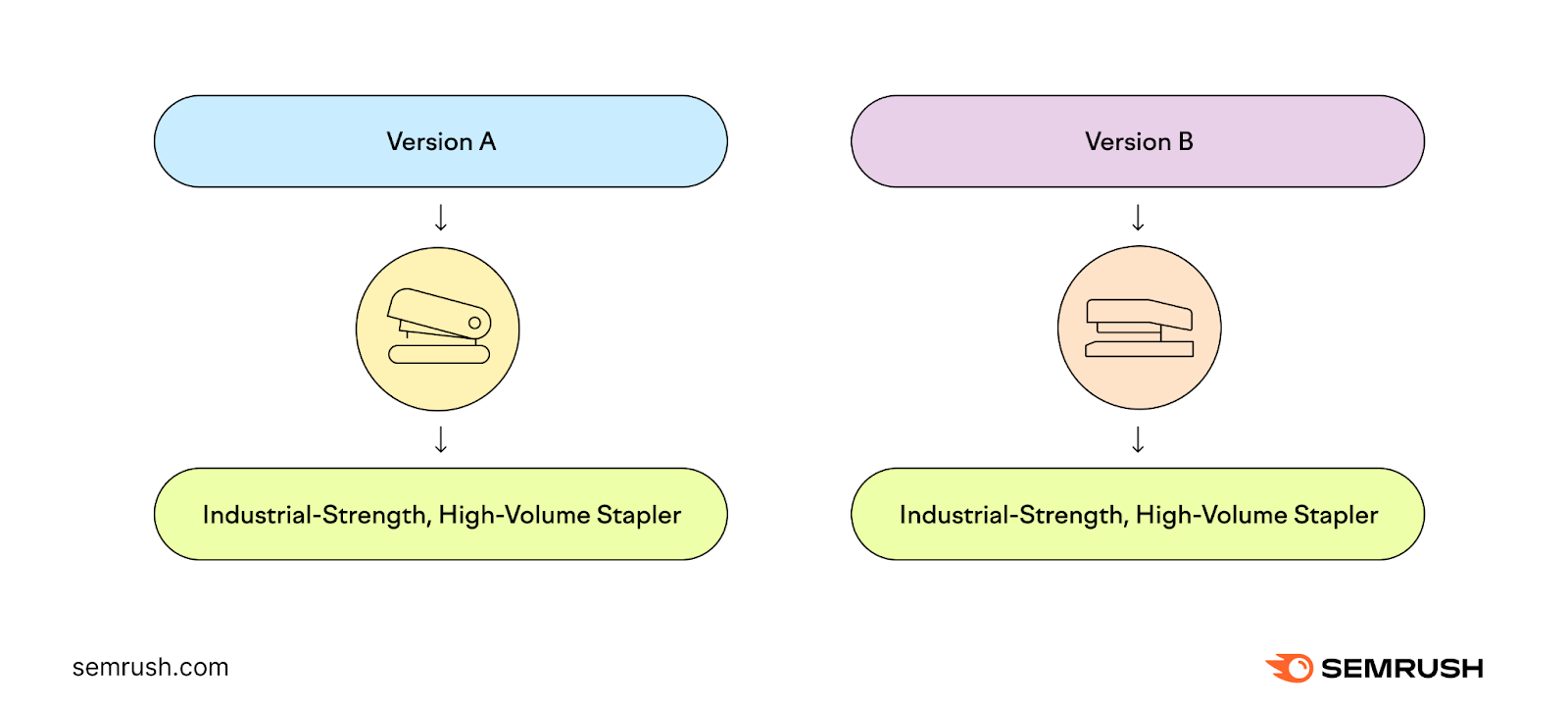
In this case, you’d test your current product image against a different one to see which performs better.
Analytics also pinpoints which marketing channels are most effective.
For example, if you notice that LinkedIn brings the highest conversions, you may want to focus your social media marketing efforts on LinkedIn.
17. Be Consistent Across Social Media Channels
A consistent presence and unified voice across social media platforms helps people recognize your brand.
And when people recognize your brand, they’re more likely to become customers, according to the Journal of Research of Social Sciences.
Social media isn’t just for B2C brands. In fact, 75% of B2B buyers use social media to make buying decisions. As a B2B brand, you can reach important decision makers on social media.
To start, identify which social media platforms decision makers in your industry spend time on. You can likely find this information by talking to past customers. Or reviewing their demographics and comparing it to usage patterns for popular social media platforms.
Once you know where to find them, create a social media marketing plan for that channel.
Repurpose the content from your website—like blog posts or help guides—into bite-sized social media posts.
Lastly, use the Social Poster tool to schedule social media content.
Here’s how.
Open the tool. Connect your social account. Then click “New post.”

Create your post and click ”Schedule.”
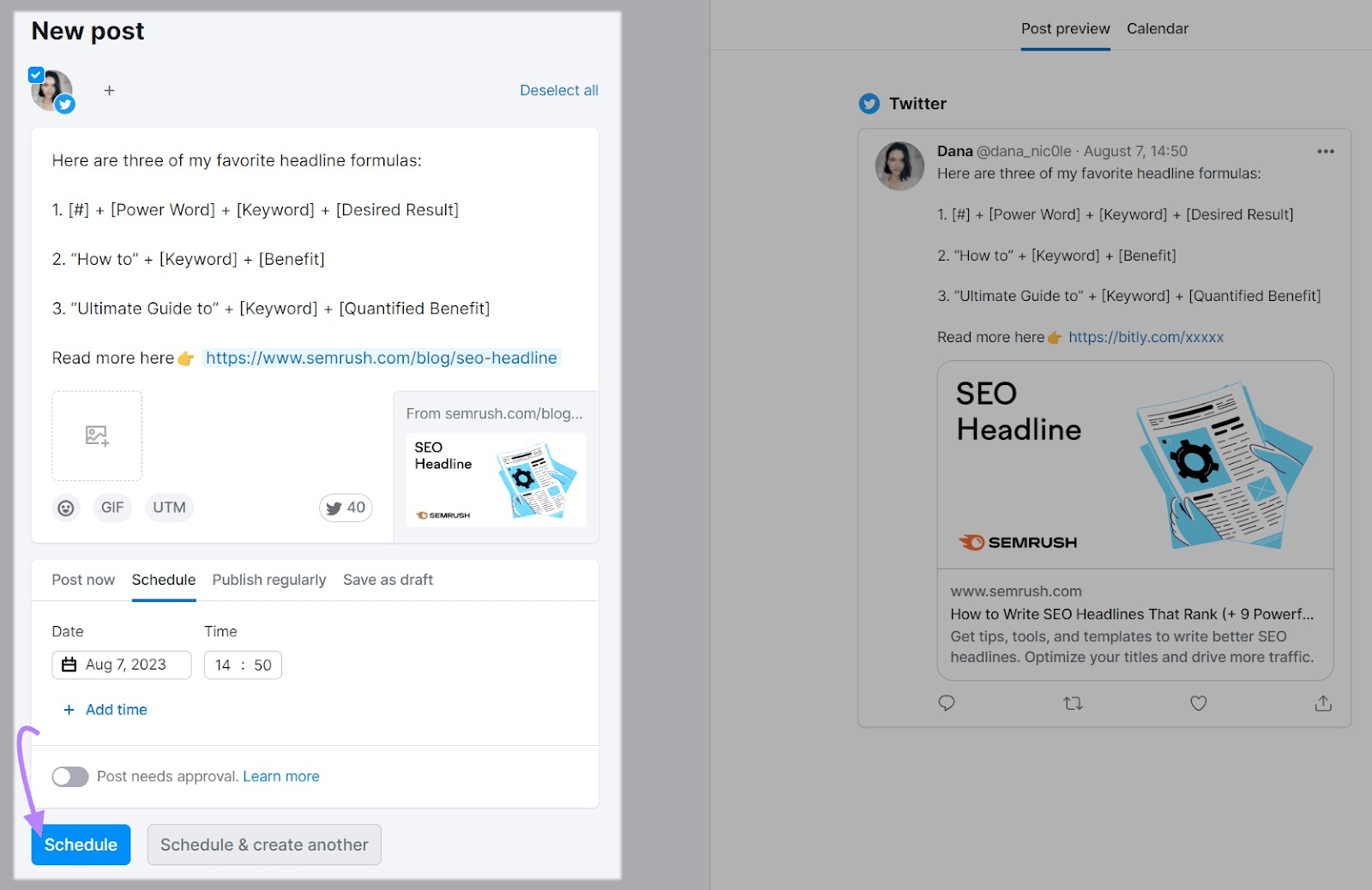
Repeat this process to create and schedule content to go live at regular intervals.
This way, potential customers see consistent content across your social media accounts.
18. Perform Competitor Analysis
Knowing how your competitors are performing in search results pages helps you spot areas of opportunity.
Use Ecommerce Keyword Analytics to analyze industry competitors and find out which keywords lead to the highest conversions.

Knowing which keywords are leading to conversions can help you identify new products that have a chance of being profitable.
Next, use EyeOn.
EyeOn lets you track your competitors so you can be the first to know when they update their pricing or introduce new products.
To start, open the tool and enter up to 20 competitor URLs. Then click “Start free monitoring.”
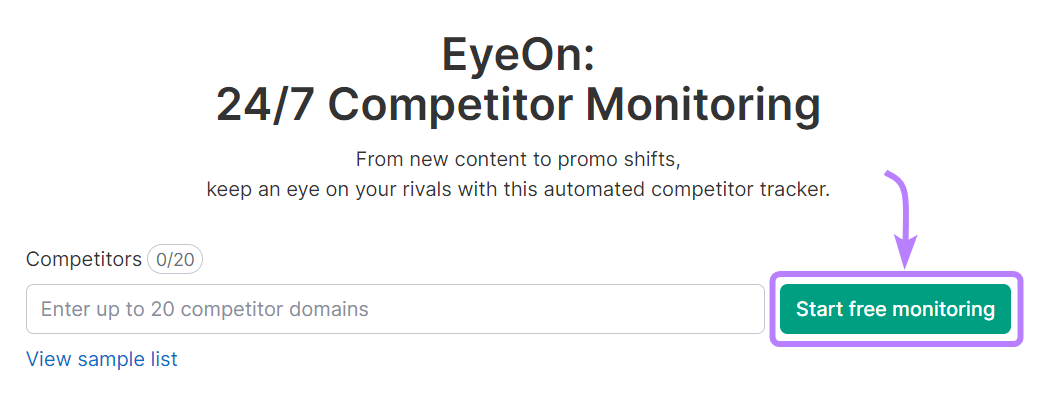
Go through the report.
Pay special attention to any new activity under “Google Search Ads” or “New Pages.”
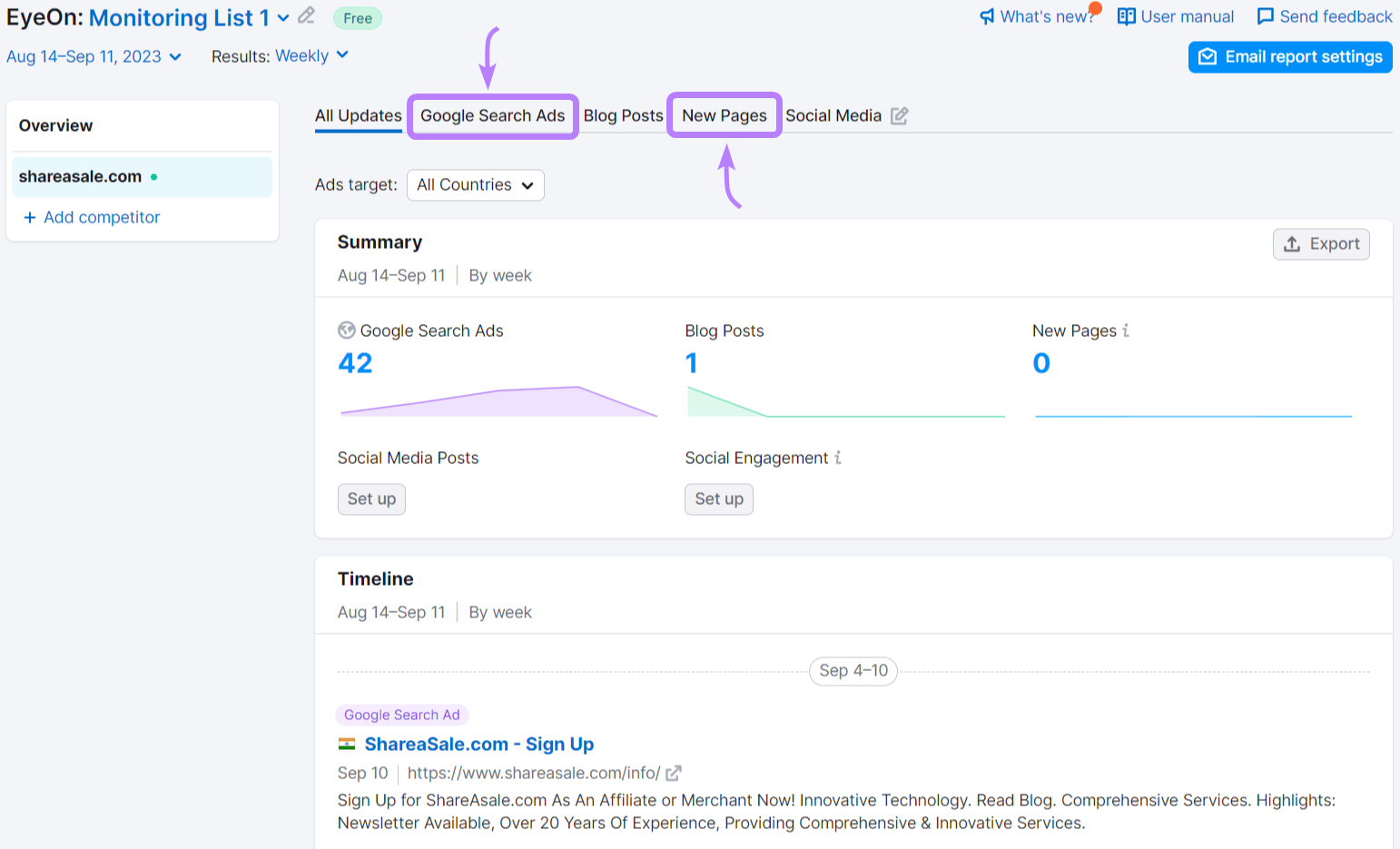
These updates can clue you into products your competitors are advertising (and ones you might want to consider advertising). Along with any new product pages they create.
You’ll also receive weekly alerts sent to your email. That way you don’t need to worry about refreshing the report each week.
Improve Your Ecommerce Site
Each best practice listed above can improve your ecommerce site and, in turn, your conversions.
And with Semrush, you can find keywords, keep an eye on your competitors, and manage social media all in one platform.
Try Semrush for free and improve your B2B ecommerce site today.
